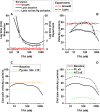Co-ordinated spatial propagation of blood plasma clotting and fibrinolytic fronts
- PMID: 28686711
- PMCID: PMC5501595
- DOI: 10.1371/journal.pone.0180668
Co-ordinated spatial propagation of blood plasma clotting and fibrinolytic fronts
Abstract
Fibrinolysis is a cascade of proteolytic reactions occurring in blood and soft tissues, which functions to disintegrate fibrin clots when they are no more needed. In order to elucidate its regulation in space and time, fibrinolysis was investigated using an in vitro reaction-diffusion experimental model of blood clot formation and dissolution. Clotting was activated by a surface with immobilized tissue factor in a thin layer of recalcified blood plasma supplemented with tissue plasminogen activator (TPA), urokinase plasminogen activator or streptokinase. Formation and dissolution of fibrin clot was monitored by videomicroscopy. Computer systems biology model of clot formation and lysis was developed for data analysis and experimental planning. Fibrin clot front propagated in space from tissue factor, followed by a front of clot dissolution propagating from the same source. Velocity of lysis front propagation linearly depended on the velocity clotting front propagation (correlation r2 = 0.91). Computer model revealed that fibrin formation was indeed the rate-limiting step in the fibrinolysis front propagation. The phenomenon of two fronts which switched the state of blood plasma from liquid to solid and then back to liquid did not depend on the fibrinolysis activator. Interestingly, TPA at high concentrations began to increase lysis onset time and to decrease lysis propagation velocity, presumably due to plasminogen depletion. Spatially non-uniform lysis occurred simultaneously with clot formation and detached the clot from the procoagulant surface. These patterns of spatial fibrinolysis provide insights into its regulation and might explain clinical phenomena associated with thrombolytic therapy.
Conflict of interest statement
Figures







Similar articles
-
Depletion of plasminogen in vitro or during thrombolytic therapy limits fibrinolytic potential.J Lab Clin Med. 1992 Jul;120(1):120-8. J Lab Clin Med. 1992. PMID: 1613318
-
Computer simulation of systemic circulation and clot lysis dynamics during thrombolytic therapy that accounts for inner clot transport and reaction.Circulation. 1996 Aug 15;94(4):763-74. doi: 10.1161/01.cir.94.4.763. Circulation. 1996. PMID: 8772700
-
Rearrangements of the fibrin network and spatial distribution of fibrinolytic components during plasma clot lysis. Study with confocal microscopy.J Biol Chem. 1996 Jan 26;271(4):2133-8. doi: 10.1074/jbc.271.4.2133. J Biol Chem. 1996. PMID: 8567670
-
Structural Biology and Protein Engineering of Thrombolytics.Comput Struct Biotechnol J. 2019 Jul 2;17:917-938. doi: 10.1016/j.csbj.2019.06.023. eCollection 2019. Comput Struct Biotechnol J. 2019. PMID: 31360331 Free PMC article. Review.
-
Cancer and blood coagulation.Cell Mol Life Sci. 2006 May;63(9):1024-7. doi: 10.1007/s00018-005-5570-9. Cell Mol Life Sci. 2006. PMID: 16612563 Free PMC article. Review.
Cited by
-
Interactions at engineered graft-tissue interfaces: A review.APL Bioeng. 2020 Aug 21;4(3):031502. doi: 10.1063/5.0014519. eCollection 2020 Sep. APL Bioeng. 2020. PMID: 32844138 Free PMC article. Review.
-
Chemical Adjustment of Fibrinolysis.Pharmaceuticals (Basel). 2024 Jan 10;17(1):92. doi: 10.3390/ph17010092. Pharmaceuticals (Basel). 2024. PMID: 38256925 Free PMC article.
-
Redistribution of TPA Fluxes in the Presence of PAI-1 Regulates Spatial Thrombolysis.Biophys J. 2020 Aug 4;119(3):638-651. doi: 10.1016/j.bpj.2020.06.020. Epub 2020 Jun 26. Biophys J. 2020. PMID: 32653051 Free PMC article.
-
The Utility and Potential of Mathematical Models in Predicting Fibrinolytic Outcomes.Curr Opin Biomed Eng. 2021 Dec;20:100337. doi: 10.1016/j.cobme.2021.100337. Epub 2021 Sep 11. Curr Opin Biomed Eng. 2021. PMID: 34957356 Free PMC article.
-
Systems Biology Approach for Personalized Hemostasis Correction.J Pers Med. 2022 Nov 15;12(11):1903. doi: 10.3390/jpm12111903. J Pers Med. 2022. PMID: 36422079 Free PMC article.
References
-
- Longstaff C, Kolev K. Basic mechanisms and regulation of fibrinolysis. J Thromb Haemost 2015. June;13 Suppl 1:S98–105. - PubMed
-
- Shibeko AM, Panteleev MA. Untangling the complexity of blood coagulation network: use of computational modelling in pharmacology and diagnostics. Brief Bioinform 2016. May;17(3):429–39. doi: 10.1093/bib/bbv040 - DOI - PubMed
-
- Panteleev MA, Balandina AN, Lipets EN, Ovanesov MV, Ataullakhanov FI. Task-oriented modular decomposition of biological networks: trigger mechanism in blood coagulation. Biophys J 2010. May 19;98(9):1751–61. doi: 10.1016/j.bpj.2010.01.027 - DOI - PMC - PubMed
-
- Collen D. On the regulation and control of fibrinolysis. Edward Kowalski Memorial Lecture. Thromb Haemost 1980. June 18;43(2):77–89. - PubMed
-
- Wiman B, Boman L, Collen D. On the kinetics of the reaction between human antiplasmin and a low-molecular-weight form of plasmin. Eur J Biochem 1978. June 1;87(1):143–6. - PubMed
MeSH terms
Substances
LinkOut - more resources
Full Text Sources
Other Literature Sources
Miscellaneous

